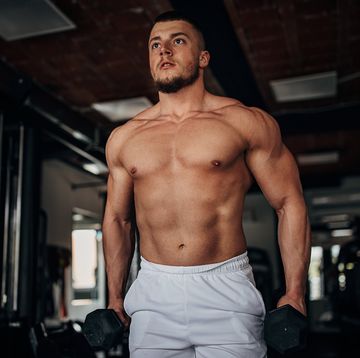Gyms are populated by two types of lifter. Sat hogging the bench is the guy who supersets a handful of reps with a heavy dose of Instagram, then looks affronted when you ask if you can jump in for a set. And over on the battle ropes – no, the versaclimber – wait, the preacher bench – is the circuit obsessive, who thinks any minute still is a minute wasted and flits between equipment like an unsated hummingbird. Even though his breathless jog from kettlebells to squat rack leaves him too exhausted to lift more than a quarter of his 1RM.
(Related: How quickly can I build visible muscle?)
Which of these guys is right? Well, neither. But also both.
You know that the amount of weight you lift, as well as the number of sets and reps you do in each workout, affects your results. But the training variable that gets least attention is what you do when you’re not moving metal.
(Related: 6 ways to speed up muscle recovery)
So both these approaches make sense some of the time. But not for everyone, and not all the time. Rest periods aren’t one-size-fits-all. They should be adjusted depending on your goals and the exercise you’re doing.
More is more
Movements like squats and deadlifts work the big muscles in your thighs, hips and lower back. As a result, they require a large amount of effort and energy. This means you need longer to recover.
This isn’t true for warm-up sets, when the weight you’re moving isn’t heavy enough to create muscle fatigue. The time it takes to change the weights is plenty. But as the weight you’re lifting becomes progressively heavier, your rest should increase too. If you’re doing heavy sets of five reps for example, you might need up to four minutes of recovery.
(Related: The secret to a gigantic deadlift)
After banging out a set of squats to failure with 85% of your 1-RM on the bar, your heart will be racing, and your lungs locked in a desperate struggle for oxygen. It can sometimes take several minutes just to get your breath back. It makes sense to rest long enough so that you’re able to put in a decent performance on your next set.
Little and often
But it’s a different story when you’re working smaller muscle groups. With exercises like the dumbbell curl or lateral raise, you don’t need to stand around waiting for several minutes before you do your next set – 60-90 seconds of rest is ample.
(Related: The 10 best dumbbell exercises)
But shifting weight and reps is your only way to bigger gains. Cutting your rest can also mean more muscle. Because even though the most important trigger for muscle growth is progressive tension overload — lifting more weight over time – there's a second stimulus for growth: metabolic fatigue.
(Related: Stretching can increase your reps by 15%)
Metabolic fatigue is the fabled "burn" – training in a way that makes your muscles feel like they're pumped up and on fire. One particularly effective way to stimulate metabolic fatigue is to shorten your rest period between sets.
So you might start out resting for 90 seconds, then next week drop down to 60 seconds. The week after, 45 seconds. Then when you bump up the weight, your rest goes with it and you cycle through the same 90, 60, 45 pattern. It’s a new weapon in your battle against plateaus.
(Related: How to optimise your tempo)
But this technique isn’t for every exercise. With something technically demanding like the squat or deadlift, avoid very short rest periods. Fatigue increases the risk that your form will break down towards the end of a set, leaving you vulnerable to injury.
The best technique
Mix up your rest in the same way you do your routines, opting for different rest periods depending on the set and rep configuration of the exercise you're doing.
For example, you might start your workout with some heavy, low-rep squats, resting for 3-4 minutes between sets. Then you move to Bulgarian split squats, but this time with higher reps and shorter rest periods. Then you finish off with the leg extension, setting your quads on fire with even higher reps and 30-second rest periods. It will hurt – and you’ll soon come to miss Instagram – but it means more results in less wasted time.














